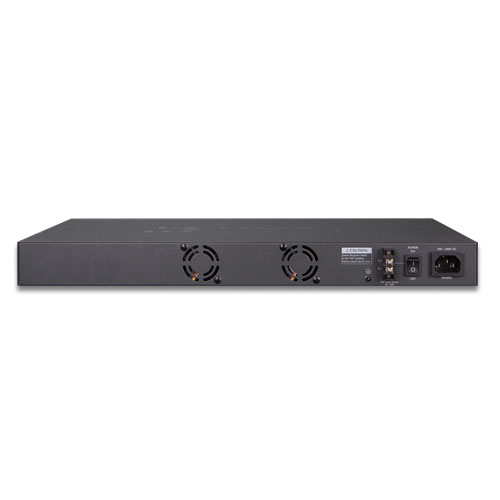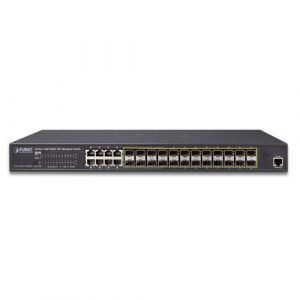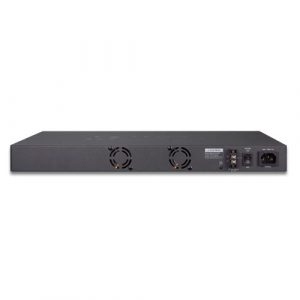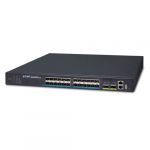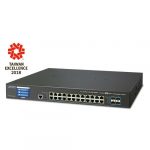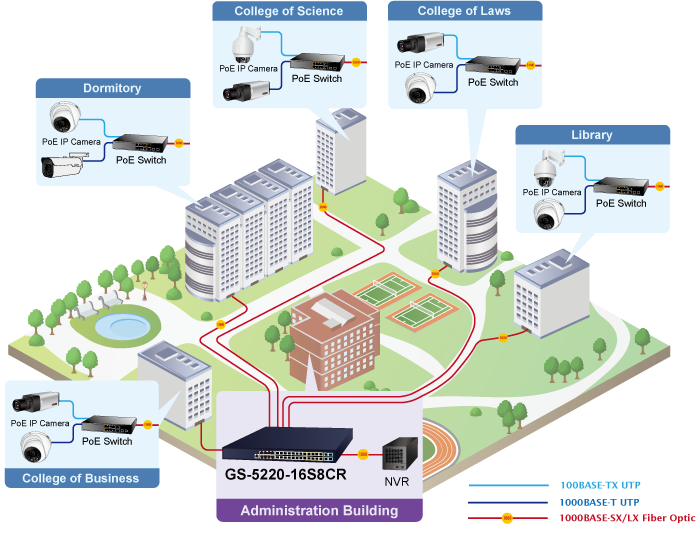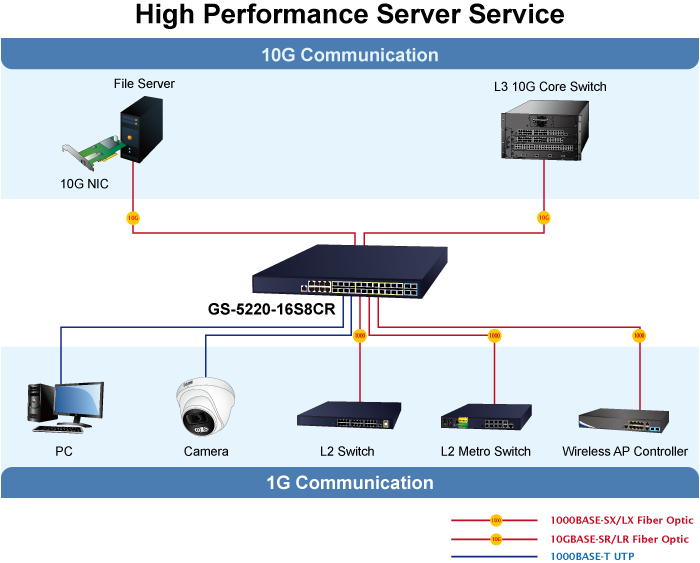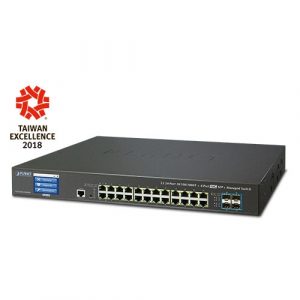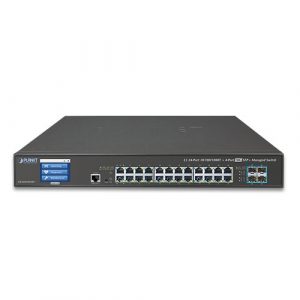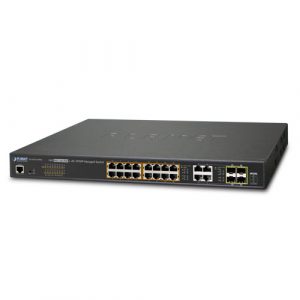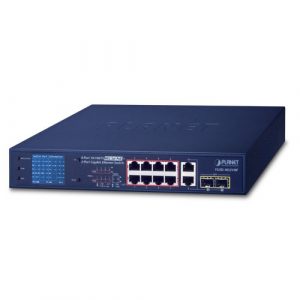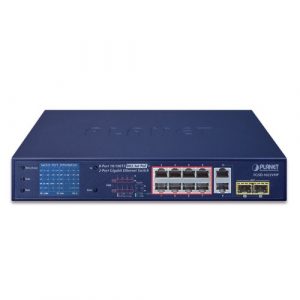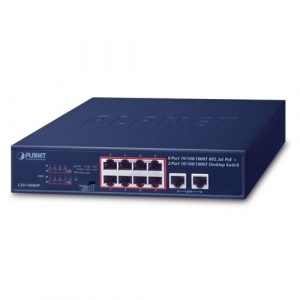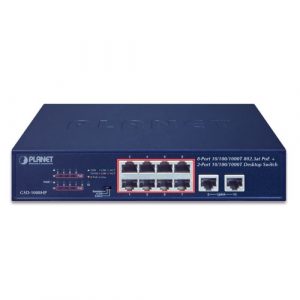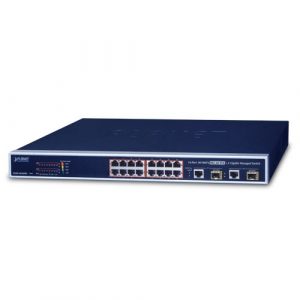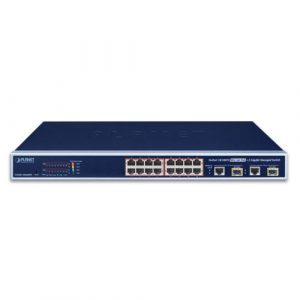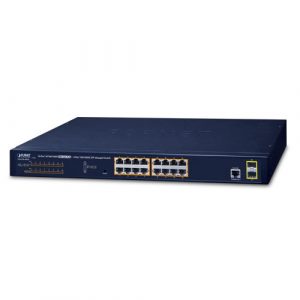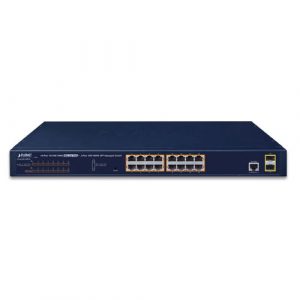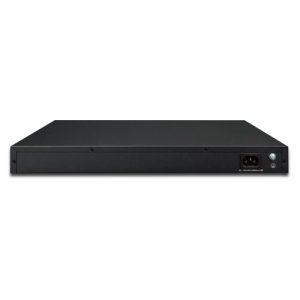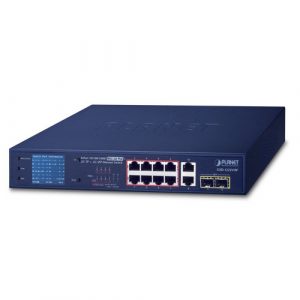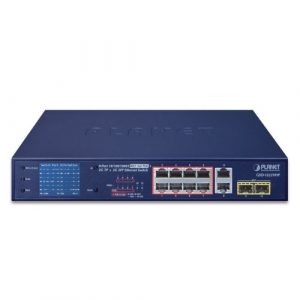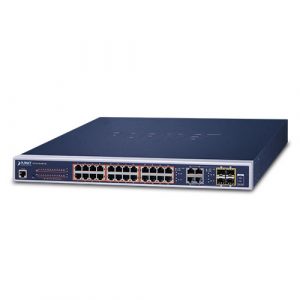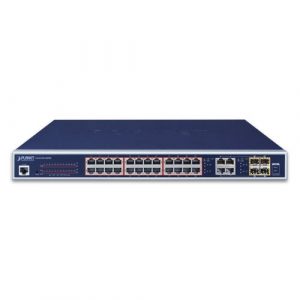GS-5220-16S8CR
L2+ 24-Port 100/1000X SFP with 8 Shared TP Managed Switches, with Hardware Layer3 IPv4/IPv6 Static Routing, W/48V Redundant Power Optional (PWR-75-48)
- Applicazioni
- SPECIFICHE
- DOWNLOAD
Descrizione
Connettività in fibra ottica a doppia velocità e multiporta flessibile per soluzioni a lunga distanza
PLANET GS-5220-16S8CR è uno switch Gigabit gestito Layer 2+ che fornisce prestazioni ad alta densità e supporta il routing statico Layer 3 con uplink da 10 Gbps e più interfacce in fibra SFP fornite in un design robusto da 1U. L’amministratore può scegliere in modo flessibile il transceiver SFP/SFP+ adatto in base alla distanza di trasmissione o alla velocità di trasmissione richiesta per estendere in modo efficiente la rete 10G. Inoltre, con la struttura di commutazione da 128 Gbps, GS-5220-16S8CR può gestire quantità di dati estremamente elevate in una topologia sicura che si collega a server backbone o ad alta capacità per applicazioni ISP e VoIP aziendale, streaming video e multicast.
Capacità Ethernet 10 Gbps ad alte prestazioni
Le quattro porte SFP+ integrate nel GS-5220-16S8CR vantano un’architettura di switch ad alte prestazioni in grado di fornire fabric switch non bloccante e throughput wire-speed fino a 128 Gbps, il che semplifica notevolmente le attività di aggiornamento della LAN per soddisfare le crescenti richieste di larghezza di banda. Ognuna delle porte SFP+ supporta 4 velocità, 10GBASE-SR/LR, 2500BASE-X, 1000BASE-SX/LX e 100BASE-FX, il che significa che l’amministratore può scegliere la velocità di trasmissione richiesta per estendere la rete in modo efficiente.
Anello ridondante, ripristino rapido per applicazioni di rete critiche
Il GS-5220-16S8CR supporta la tecnologia ad anello ridondante e presenta una capacità di ripristino rapido e potente per prevenire interruzioni e intrusioni esterne. Incorpora la tecnologia avanzata ITU-T G.8032 ERPS (Ethernet Ring Protection Switching) e il protocollo Spanning Tree (802.1s MSTP) nella rete del cliente per migliorare l’affidabilità e i tempi di attività del sistema in ambienti difficili.
Switch di routing multi fibra per applicazioni di sorveglianza IP PoE ad ampia copertura
Con 24 interfacce in fibra SFP con 8 porte Gigabit condivise e capacità di routing statico IP Layer 3, il GS-5220-16S8CR fornisce una soluzione conveniente e ad alte prestazioni per aziende, provider di servizi di rete, campus e telecomunicazioni.
Soluzione di rete mesh ad alta disponibilità per sistemi Big Data
Con caratteristiche altamente flessibili, altamente estensibili e facili da installare, il GS-5220-16S8CR offre una velocità di scambio dati fino a 128 Gbps tramite interfaccia in fibra ottica e la distanza di trasmissione può essere estesa fino a 120 km. Il GS-5220-16S8CR è dotato di una capacità di autoripristino rapida e potente per prevenire interruzioni e intrusioni esterne. Incorpora IEEE 802.1s MSTP (Multiple Spanning Tree Protocol, spanning tree tramite VLAN) nella rete di automazione del cliente per migliorare l’affidabilità e i tempi di attività del sistema. Il GS-5220-16S8CR è la soluzione ideale per data center, service provider e telecomunicazioni per creare connessioni ridondanti e stabilire un’elevata larghezza di banda per la server farm Big Data.
Ottima soluzione per la sicurezza del core/data center e lo switch QoS
Il GS-5220-16S8CR esegue uno switch fabric non bloccante da 128 Gbps, quindi può facilmente fornire una rete Ethernet locale ad alta larghezza di banda da 10 Gbps per il backbone del tuo dipartimento. Con le quattro porte SFP+ integrate, il GS-5220-16S8CR fornisce l’uplink alla rete backbone tramite i moduli SFP+ LR/SR Ethernet 10G. Migliora ulteriormente l’efficienza della rete e protegge i client di rete offrendo le funzionalità di sicurezza e QoS.
| Hardware Specifications | |
|---|---|
| Copper Ports | 8 10/100/1000Base-T RJ-45 Auto-MDI/MDI-X ports, shared with Port-1~Port-8 |
| SFP/mini-GBIC Slots | 24 100/1000Base-X dual-speed SFP interfaces |
| Console | 1 x RS-232-to-RJ45 serial port (115200, 8, N, 1) |
| Switch Architecture | Store-and-Forward |
| Switch Fabric | 48Gbps / non-blocking |
| Throughput | 35.7Mpps@64Bytes |
| Address Table | 16K entries, automatic source address learning and ageing |
| Shared Data Buffer | 16M bits |
| Flow Control | IEEE 802.3x pause frame for full-duplex Back pressure for half-duplex |
| Jumbo Frame | 10K bytes |
| Reset Button | < 5 sec: System reboot > 5 sec: Factory default |
| Dimensions (W x D x H) | 440 x 200 x 44.5 mm, 1U height |
| Weight | 2745g |
| LED | System: PWR (Green) DC (Green) (GS-5220-16S8CR Only) Fault (Red) FAN (Red) 10/100/1000T RJ45 Interfaces (Port 1 to Port 8): 1000Mbps LNK/ACT (Green) 10/100Mbps LNK/ACT (Orange) 100/1000Mbps SFP Interfaces (Port 1 to Port 24): 1000Mbps LNK/ACT (Green) 100Mbps LNK/ACT (Orange) |
| Power Requirements | GS-5220-16S8C: 100~240V AC, 50/60Hz GS-5220-16S8CR: 100~240V AC, 50/60Hz 48V DC @ 0.6A, Range: 36 ~ 60V |
| Power Consumption | 45 watts / 153 BTU (max.) |
| ESD Protection | 6KV DC |
| Layer 2 Functions | |
| Port Configuration | Port disable / enable Auto-negotiation 10/100/1000Mbps full and half duplex mode selection Flow control disable / enable |
| Port Status | Display each port’s speed duplex mode, link status, flow control status, auto-negotiation status, trunk status |
| Port Mirroring | TX / RX / Both Many-to-1 monitor |
| VLAN | 802.1Q tagged based VLAN Q-in-Q tunneling Private VLAN Edge (PVE) MAC-based VLAN Protocol-based VLAN Voice VLAN IP Subnet-based VLAN MVR (Multicast VLAN Registration) Up to 255 VLAN groups, out of 4094 VLAN IDs |
| Link Aggregation | IEEE 802.3ad LACP / Static Trunk 12 groups of 8-port trunk supported |
| Spanning Tree Protocol | STP, IEEE 802.1D Spanning Tree Protocol RSTP, IEEE 802.1w Rapid Spanning Tree Protocol MSTP, IEEE 802.1s Multiple Spanning Tree Protocol |
| QoS | Traffic classification based, Strict priority and WRR 8-Level priority for switching – Port Number – 802.1p priority – 802.1Q VLAN tag – DSCP/TOS field in IP packet |
| IGMP Snooping | IGMP (v1/v2/v3) Snooping, up to 255 multicast groups IGMP Querier mode support |
| MLD Snooping | MLD (v1/v2) Snooping, up to 255 multicast groups MLD Querier mode support |
| Access Control List | IP-based ACL / MAC-based ACL Up to 256 entries |
| Bandwidth Control | Per port bandwidth control Ingress: 100Kbps~1000Mbps Egress: 100Kbps~1000Mbps |
| Layer 3 Functions | |
| IP Interfaces | Max. 128 VLAN interfaces |
| Routing Table | Max. 32 routing entries |
| Routing Protocols | IPv4 hardware Static Routing IPv6 hardware Static Routing |
| Management | |
| Basic Management Interfaces | Console / Telnet / Web browser / SNMP v1, v2c |
| Secure Management Interfaces | SSH, SSL, SNMP v3 |
| SNMP MIBs | RFC 1213 MIB-II RFC 1493 Bridge MIB RFC 1643 Ethernet MIB RFC 2863 Interface MIB RFC 2665 Ether-Like MIB RFC 2819 RMON MIB (Group 1, 2, 3 and 9) RFC 2737 Entity MIB RFC 2618 RADIUS Client MIB RFC 2863 IF-MIB RFC 2933 IGMP-STD-MIB RFC 3411 SNMP-Frameworks-MIB RFC 4292 IP Forward MIB RFC 4293 IP MIB RFC 4836 MAU-MIB IEEE 802.1X PAE LLDP |
| Standards Conformance | |
| Regulation Compliance | FCC Part 15 Class A, CE |
| Standards Compliance | IEEE 802.3 10Base-T IEEE 802.3u 100Base-TX/100Base-FX IEEE 802.3z Gigabit SX/LX IEEE 802.3ab Gigabit 1000Base-T IEEE 802.3x Flow Control and Back pressure IEEE 802.3ad port trunk with LACP IEEE 802.1D Spanning Tree protocol IEEE 802.1w Rapid Spanning Tree protocol IEEE 802.1s Multiple Spanning Tree protocol IEEE 802.1p Class of service IEEE 802.1Q VLAN tagging IEEE 802.1X port authentication network control IEEE 802.1ab LLDP RFC 768 UDP RFC 793 TFTP RFC 791 IP RFC 792 ICMP RFC 2068 HTTP RFC 1112 IGMP version 1 RFC 2236 IGMP version 2 RFC 3376 IGMP version 3 RFC 2710 MLD version 1 FRC 3810 MLD version 2 |
| Environment | |
| Operating | Temperature: 0 ~ 50 degrees C Relative Humidity: 5 ~ 95% (non-condensing) |
| Storage | Temperature: -10 ~ 70 degrees C Relative Humidity: 5 ~ 95% (non-condensing) |





